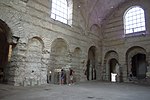Sainte-Geneviève-des-Ardents, Paris
1747 disestablishments in EuropeBuildings and structures demolished in 1747Destroyed churches in FranceFormer Roman Catholic church buildingsFormer buildings and structures in Paris ... and 4 more
France Roman Catholic church stubsRoman Catholic churches in the 4th arrondissement of ParisÎle-de-France geography stubsÎle de la Cité

Sainte-Geneviève-des-Ardents (French pronunciation: [sɛ̃t ʒə.nə.vjɛv də.z‿aʁ.dɑ̃]), known as Sainte-Geneviève-la-Petite in the Middle Ages, was a church located at present-day Parvis Notre-Dame – Place Jean-Paul-II in the Île de la Cité in Paris, France. It is dedicated to Saint Genevieve, the miracles imputed to whom included "the cessation of a horrible plague, called the mal ardent, which desolated Paris in the reign of Louis le Gros".
Excerpt from the Wikipedia article Sainte-Geneviève-des-Ardents, Paris (License: CC BY-SA 3.0, Authors, Images).Sainte-Geneviève-des-Ardents, Paris
Parvis Notre-Dame - Place Jean-Paul II, Paris 4th Arrondissement (Paris)
Geographical coordinates (GPS) Address Phone number Website Nearby Places Show on map
Geographical coordinates (GPS)
| Latitude | Longitude |
|---|---|
| N 48.85373 ° | E 2.34796 ° |
Address
Crypte Archéologique du Parvis Notre-Dame
Parvis Notre-Dame - Place Jean-Paul II
75004 Paris, 4th Arrondissement (Paris)
Ile-de-France, France
Open on Google Maps










